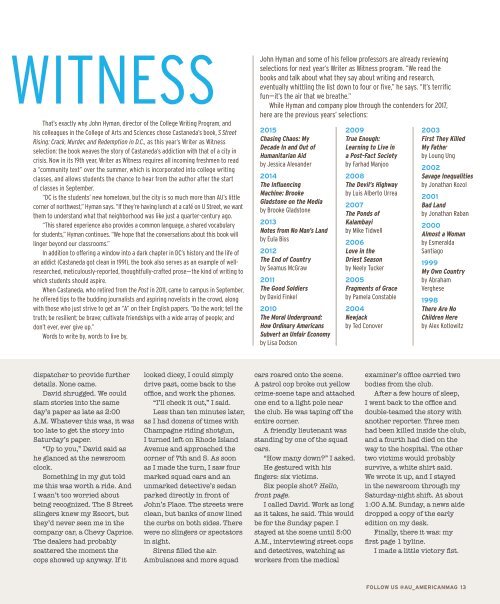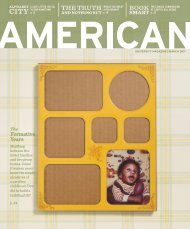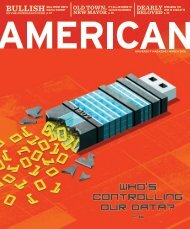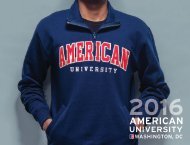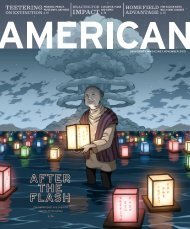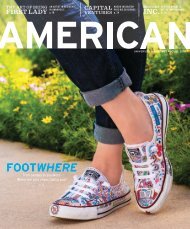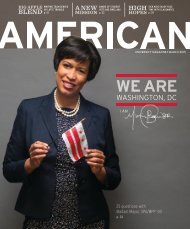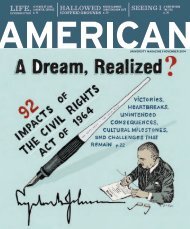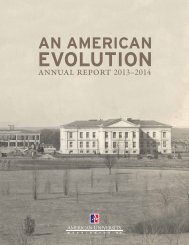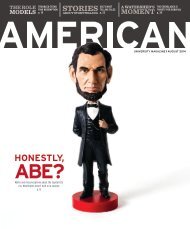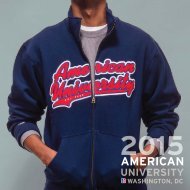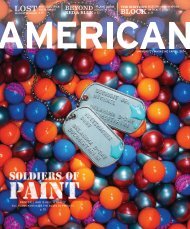American Magazine: November 2016
In this issue, delve into the Scandal-ous life of Judy Smith, meet ESPN’s new public editor, reflect on a decade of transformation under President Neil Kerwin, and learn more about autism—the fastest growing developmental disorder in the United States. Hop on the Metro to Capitol South and get to know a few of AU’s 1,068 Seattle transplants.
In this issue, delve into the Scandal-ous life of Judy Smith, meet ESPN’s new public editor, reflect on a decade of transformation under President Neil Kerwin, and learn more about autism—the fastest growing developmental disorder in the United States. Hop on the Metro to Capitol South and get to know a few of AU’s 1,068 Seattle transplants.
Create successful ePaper yourself
Turn your PDF publications into a flip-book with our unique Google optimized e-Paper software.
WITNESS<br />
That’s exactly why John Hyman, director of the College Writing Program, and<br />
his colleagues in the College of Arts and Sciences chose Castaneda’s book, S Street<br />
Rising: Crack, Murder, and Redemption in D.C., as this year’s Writer as Witness<br />
selection: the book weaves the story of Castaneda’s addiction with that of a city in<br />
crisis. Now in its 19th year, Writer as Witness requires all incoming freshmen to read<br />
a “community text” over the summer, which is incorporated into college writing<br />
classes, and allows students the chance to hear from the author after the start<br />
of classes in September.<br />
“DC is the students’ new hometown, but the city is so much more than AU’s little<br />
corner of northwest,” Hyman says. “If they’re having lunch at a café on U Street, we want<br />
them to understand what that neighborhood was like just a quarter-century ago.<br />
“This shared experience also provides a common language, a shared vocabulary<br />
for students,” Hyman continues. “We hope that the conversations about this book will<br />
linger beyond our classrooms.”<br />
In addition to offering a window into a dark chapter in DC’s history and the life of<br />
an addict (Castaneda got clean in 1991), the book also serves as an example of wellresearched,<br />
meticulously-reported, thoughtfully-crafted prose—the kind of writing to<br />
which students should aspire.<br />
When Castaneda, who retired from the Post in 2011, came to campus in September,<br />
he offered tips to the budding journalists and aspiring novelists in the crowd, along<br />
with those who just strive to get an “A” on their English papers. “Do the work; tell the<br />
truth; be resilient; be brave; cultivate friendships with a wide array of people; and<br />
don’t ever, ever give up.”<br />
Words to write by, words to live by.<br />
John Hyman and some of his fellow professors are already reviewing<br />
selections for next year’s Writer as Witness program. “We read the<br />
books and talk about what they say about writing and research,<br />
eventually whittling the list down to four or five,” he says. “It’s terrific<br />
fun—it’s the air that we breathe.”<br />
While Hyman and company plow through the contenders for 2017,<br />
here are the previous years’ selections:<br />
2015<br />
Chasing Chaos: My<br />
Decade In and Out of<br />
Humanitarian Aid<br />
by Jessica Alexander<br />
2014<br />
The Influencing<br />
Machine: Brooke<br />
Gladstone on the Media<br />
by Brooke Gladstone<br />
2013<br />
Notes from No Man’s Land<br />
by Eula Biss<br />
2012<br />
The End of Country<br />
by Seamus McGraw<br />
2011<br />
The Good Soldiers<br />
by David Finkel<br />
2010<br />
The Moral Underground:<br />
How Ordinary <strong>American</strong>s<br />
Subvert an Unfair Economy<br />
by Lisa Dodson<br />
2009<br />
True Enough:<br />
Learning to Live in<br />
a Post-Fact Society<br />
by Farhad Manjoo<br />
2008<br />
The Devil’s Highway<br />
by Luis Alberto Urrea<br />
2007<br />
The Ponds of<br />
Kalambayi<br />
by Mike Tidwell<br />
2006<br />
Love in the<br />
Driest Season<br />
by Neely Tucker<br />
2005<br />
Fragments of Grace<br />
by Pamela Constable<br />
2004<br />
Newjack<br />
by Ted Conover<br />
2003<br />
First They Killed<br />
My Father<br />
by Loung Ung<br />
2002<br />
Savage Inequalities<br />
by Jonathan Kozol<br />
2001<br />
Bad Land<br />
by Jonathan Raban<br />
2000<br />
Almost a Woman<br />
by Esmeralda<br />
Santiago<br />
1999<br />
My Own Country<br />
by Abraham<br />
Verghese<br />
1998<br />
There Are No<br />
Children Here<br />
by Alex Kotlowitz<br />
dispatcher to provide further<br />
details. None came.<br />
David shrugged. We could<br />
slam stories into the same<br />
day’s paper as late as 2:00<br />
A.M. Whatever this was, it was<br />
too late to get the story into<br />
Saturday’s paper.<br />
“Up to you,” David said as<br />
he glanced at the newsroom<br />
clock.<br />
Something in my gut told<br />
me this was worth a ride. And<br />
I wasn’t too worried about<br />
being recognized. The S Street<br />
slingers knew my Escort, but<br />
they’d never seen me in the<br />
company car, a Chevy Caprice.<br />
The dealers had probably<br />
scattered the moment the<br />
cops showed up anyway. If it<br />
looked dicey, I could simply<br />
drive past, come back to the<br />
office, and work the phones.<br />
“I’ll check it out,” I said.<br />
Less than ten minutes later,<br />
as I had dozens of times with<br />
Champagne riding shotgun,<br />
I turned left on Rhode Island<br />
Avenue and approached the<br />
corner of 7th and S. As soon<br />
as I made the turn, I saw four<br />
marked squad cars and an<br />
unmarked detective’s sedan<br />
parked directly in front of<br />
John’s Place. The streets were<br />
clean, but banks of snow lined<br />
the curbs on both sides. There<br />
were no slingers or spectators<br />
in sight.<br />
Sirens filled the air.<br />
Ambulances and more squad<br />
cars roared onto the scene.<br />
A patrol cop broke out yellow<br />
crime-scene tape and attached<br />
one end to a light pole near<br />
the club. He was taping off the<br />
entire corner.<br />
A friendly lieutenant was<br />
standing by one of the squad<br />
cars.<br />
“How many down?” I asked.<br />
He gestured with his<br />
fingers: six victims.<br />
Six people shot? Hello,<br />
front page.<br />
I called David. Work as long<br />
as it takes, he said. This would<br />
be for the Sunday paper. I<br />
stayed at the scene until 5:00<br />
A.M., interviewing street cops<br />
and detectives, watching as<br />
workers from the medical<br />
examiner’s office carried two<br />
bodies from the club.<br />
After a few hours of sleep,<br />
I went back to the office and<br />
double-teamed the story with<br />
another reporter. Three men<br />
had been killed inside the club,<br />
and a fourth had died on the<br />
way to the hospital. The other<br />
two victims would probably<br />
survive, a white shirt said.<br />
We wrote it up, and I stayed<br />
in the newsroom through my<br />
Saturday-night shift. At about<br />
1:00 A.M. Sunday, a news aide<br />
dropped a copy of the early<br />
edition on my desk.<br />
Finally, there it was: my<br />
first page 1 byline.<br />
I made a little victory fist.<br />
FOLLOW US @AU_AMERICANMAG 13


